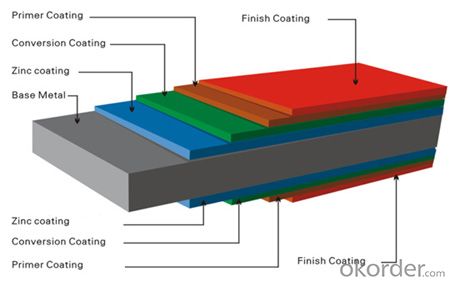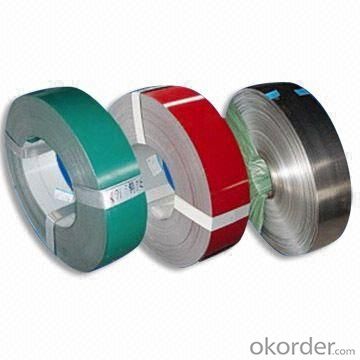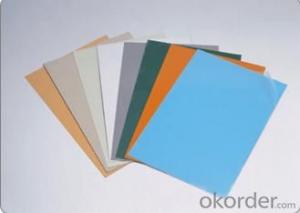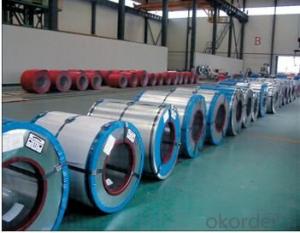Prepainted steel coils Prime quality steel coils
- Loading Port:
- Shanghai
- Payment Terms:
- TT OR LC
- Min Order Qty:
- 50 m.t.
- Supply Capability:
- 100000 m.t./month
OKorder Service Pledge
OKorder Financial Service
You Might Also Like
Quick Details
| Standard: | AISI,ASTM,DIN,JIS | Grade: | steel | Thickness: | 0.17-1.5mm |
| Place of Origin: | China (Mainland) | Brand Name: | CNBM | Model Number: | SGCC Q195L, Q235, DX51D |
| Type: | Steel Coil | Technique: | Hot Rolled,hot dip | Surface Treatment: | Coated |
| Application: | Flange Plate | Special Use: | Steel | Width: | 600-1250mm |
| Length: | 2000-6000mm |
Specifications
1.reasonable price
2.reliable quality
3.fast shipment
4.huge production capacity
5.BV,SGS and TUV certificates
Prepainted Steel coil PPGI



| Commodity | Prepanited steel coil |
| Grade | JIS G3302(SGCC), DX51D, EN10142, GB/T2518-2004, ASTM 653 |
| Standard | ASTM, AISI, DIN, GB |
| Types | Commercial / Drawing / Deep Drawing / Structural quality |
| Width | 500/650/726/820/914/1000/1200/1219/1220/1250mm |
| Thickness | 0.16-1.2mm (0.14-0.5mm is the most advantage thickness) |
| Type of coating | Galvanized |
| Zinc / PE coating | Z60-275g/m2 ,12-20μm(top)/7-10μm(bottom) |
| Surface | RAL System as per customers request |
| ID coil | 508mm |
| Coil weight | 4-6MT |
| Package | Properly packed for ocean freight exportation |
| Application | Industrial panels, roofing and siding for painting |
| Payment terms | 30%TT in advance+70% TT or irrevocable 100%L/C at sight |
| Delivery time | 25 days after recepit of 30% TT or L/C |
PACKING
4 eye bands and 4 circumferential bands in steel, galvanized metal fluted rings on inner and outer edges, galvanized metal & waterproof paper wall protection disk, galvanized metal & waterproof paper around circumference and bore protection
FAQ
We have organized several common questions for our clients,may help you sincerely:
1)How to guarantee the quality of the products?
We have established the international advanced quality management system,every link from raw material to final product we have strict quality test;We resolutely put an end to unqualified products flowing into the market. At the same time, we will provide necessary follow-up service assurance.
2)How long can we receive the product after purchase?
In the purchase of product within 20-25 days, we will arrange the factory delivery as soon as possible. The pacific time of receiving is related to the state and position of customers. Commonly 15 to 30 days can be served.
3)Syringes are CE,FDA approved. And we supplied main nations in the world.
- Q:What are the different coating options for steel coils?
- Steel coils have multiple options for coating, each with its own purpose and benefits. Some commonly used coatings for steel coils include the following: 1. Galvanized Coating: Steel coils are immersed in molten zinc, resulting in a zinc layer on the surface. This coating offers excellent corrosion resistance and protects against rust. It is ideal for harsh environments and moisture exposure. 2. Galvannealed Coating: This coating combines galvanizing and annealing processes. After galvanizing, the steel coils are annealed to create a zinc-iron alloy layer. Galvannealed coating provides enhanced paintability, weldability, and corrosion resistance. 3. Aluminum-Zinc Alloy Coating: Also known as Galvalume, this coating involves applying an aluminum-zinc alloy to the steel coils. It offers excellent corrosion resistance and heat reflectivity, making it suitable for roofing, siding, and automotive parts. 4. Organic Coatings: These coatings are typically applied as a top layer over a base coat of galvanized or galvannealed coating. Examples include paints, lacquers, and powder coatings. Organic coatings provide additional protection against corrosion, UV rays, and abrasion while enhancing the aesthetics of the steel coils. 5. Chromate Conversion Coating: This coating is commonly used as a pre-treatment before applying organic coatings. It improves adhesion between the steel surface and the organic coating, ensuring better corrosion resistance. The choice of coating depends on factors such as the intended application, environmental conditions, desired appearance, and budget. Manufacturers and end-users should carefully consider these factors to select the most suitable coating option for their specific requirements.
- Q:What is the thickness range of steel coils?
- The thickness range of steel coils varies depending on the specific application and industry. However, generally speaking, steel coils can have a thickness range from as thin as 0.005 inches (0.13 mm) to as thick as 0.5 inches (12.7 mm) or more.
- Q:I Don't have a Oxy act. torch but can Get a Propane one. The finished part(s) are .375 x .550 x .185
- I think 12L14 is NOT heat hardenable, because it is low-carbon. You may try heating and quenching it, but it won't harden much. It can be hardened by cold-working - drawing or rolling processes. However, these are usually done by the material manufactures, and most machine shops do not have the capability to do this in house. Can you try 1144 steel instead? 1144 is medium-carbon (0.44%), and heat treatable. It is also free machining grade like 12L14. Other medium carbon steels are also heat hardenable: 1040, 1050, etc.
- Q:What are the dimensions of steel coils used in the power generation industry?
- The dimensions of steel coils used in the power generation industry vary depending on the specific application and requirements. However, common dimensions for steel coils used in this industry are typically in the range of 0.5 to 3.0 millimeters in thickness and 600 to 2000 millimeters in width. The length of the coil can vary, but it is often in the range of several hundred to several thousand meters.
- Q:What are the different types of welding methods used for steel coils?
- There are several types of welding methods used for steel coils, including: 1. Shielded Metal Arc Welding (SMAW): Also known as stick welding, it uses a flux-coated electrode to create an arc between the electrode and the base metal, forming a weld. 2. Gas Metal Arc Welding (GMAW): Also called MIG welding, it uses a continuous wire electrode and a shielding gas, typically argon or a mixture, to create a weld. 3. Flux-Cored Arc Welding (FCAW): Similar to GMAW, but instead of a solid wire electrode, it uses a tubular electrode filled with flux, which provides additional shielding and can be used with or without a shielding gas. 4. Submerged Arc Welding (SAW): It involves a continuous wire electrode and a granular flux that is fed under a layer of flux, creating a submerged arc and a highly efficient weld. 5. Resistance Welding: It utilizes electricity to generate heat and pressure, joining the steel coils together. Types of resistance welding include spot welding, seam welding, and projection welding. Each welding method has its own advantages and limitations, and the choice depends on factors such as the specific requirements of the steel coils, the thickness of the material, and the production process.
- Q:What are the safety regulations for steel coil production facilities?
- The safety regulations for steel coil production facilities differ depending on the specific country or region. However, these facilities typically implement some common safety measures. One primary safety regulation is the proper training and education of employees. All workers in steel coil production facilities must undergo training on potential hazards and the correct safety procedures to follow. This includes training on handling heavy machinery, operating cranes or forklifts, and understanding the risks associated with working in a high-temperature environment. Maintenance and inspection of equipment are also important safety regulations. Regular inspections should be carried out to ensure that machinery and equipment are in good working condition and do not pose any safety risks. Moreover, maintenance procedures should be implemented to promptly address any issues or malfunctions. Fire safety is a crucial aspect of safety regulations in steel coil production facilities. Fire prevention measures like fire alarms, sprinkler systems, and fire extinguishers should be installed. Regular fire drills should also be conducted to ensure that all employees are familiar with evacuation procedures and can respond swiftly and effectively in case of a fire emergency. The use of personal protective equipment (PPE) is another vital safety requirement in steel coil production facilities. Employees must be provided with appropriate PPE such as safety glasses, helmets, gloves, and steel-toed boots to protect them from potential hazards like falling objects, sharp edges, and high temperatures. Additionally, safety regulations often necessitate the implementation of safety barriers and guards around machinery and equipment to prevent accidents and injuries. This includes safety gates, railings, and protective covers that restrict access to hazardous areas and prevent unauthorized entry. Regular safety audits and inspections should be conducted by relevant authorities or safety professionals to ensure compliance with safety regulations. Companies should also foster a culture of safety by encouraging open communication about safety concerns, providing safety training and refresher courses, and rewarding employees for adhering to safety protocols. It is important to note that safety regulations may vary across jurisdictions, and it is advisable to consult the specific regulations applicable in the country or region where the steel coil production facility is located.
- Q:How are steel coils coated to prevent rust and corrosion?
- Steel coils are coated to prevent rust and corrosion through a process called galvanization. This involves immersing the coils in a bath of molten zinc, which forms a protective layer on the steel surface. This zinc coating acts as a barrier, preventing oxygen and moisture from coming into contact with the steel, thus reducing the risk of rust and corrosion.
- Q:I bought stainless steel appliances a year ago. I have two kids who like to put their hands all over the fridge and they always leave dirty marks all over it. I bought stainless steel cleaner but it doesn't do a good enough job. Anyone know any other cleaning remedies?
- All the stainless steel cleaners I've tried are fine for polishing, but they don't clean anything. A damp microfiber towel (the kind with loops like terry cloth) does a good job. You might be able to use plain water because the cloths are so good. Or mix up some dish soap in water and wet the towel with that. You can use windex if you want something more convenient.
- Q:How are steel coils used in the production of metal cabinets?
- Steel coils are an essential component in the production of metal cabinets. These coils are made from thin sheets of steel that have been wound into a tightly coiled shape. The first step in using steel coils for metal cabinet production is uncoiling them. This is done by unwinding the coil and feeding the steel sheet into a machine that cuts it to the desired length. The length of the sheet will depend on the size and dimensions of the metal cabinet being produced. Once the steel sheet has been cut, it undergoes a process called blanking. This involves cutting out the various panels and parts needed for the metal cabinet, such as the sides, top, bottom, and doors. The blanking process is typically done using a stamping press or a laser cutting machine, which ensures precision and accuracy in shaping the steel sheet. After the blanking process, the individual panels are then formed and shaped using a series of bending and forming machines. These machines apply pressure and force to the steel panels, bending them into the desired shape and creating the necessary angles and curves required for the metal cabinet design. Once the panels have been formed, they are usually joined together using welding or fastening techniques. Welding involves fusing the edges of the steel panels together using heat, while fastening techniques may involve using screws, bolts, or rivets to secure the panels in place. Overall, steel coils play a crucial role in the production of metal cabinets as they provide the raw material from which the individual panels are made. The use of steel coils allows for greater flexibility and efficiency in manufacturing metal cabinets, as it enables mass production and customization of cabinet designs.
- Q:How are steel coils used in the production of prefabricated buildings?
- Steel coils are used in the production of prefabricated buildings as they serve as a primary material for manufacturing structural components such as beams, columns, and frames. These coils are unrolled and shaped into various sections, which are then welded or bolted together to form the skeleton of the building. Their strength, durability, and malleability make steel coils an ideal choice for constructing robust and reliable prefabricated structures.
1. Manufacturer Overview |
|
|---|---|
| Location | |
| Year Established | |
| Annual Output Value | |
| Main Markets | |
| Company Certifications | |
2. Manufacturer Certificates |
|
|---|---|
| a) Certification Name | |
| Range | |
| Reference | |
| Validity Period | |
3. Manufacturer Capability |
|
|---|---|
| a)Trade Capacity | |
| Nearest Port | |
| Export Percentage | |
| No.of Employees in Trade Department | |
| Language Spoken: | |
| b)Factory Information | |
| Factory Size: | |
| No. of Production Lines | |
| Contract Manufacturing | |
| Product Price Range | |
Send your message to us
Prepainted steel coils Prime quality steel coils
- Loading Port:
- Shanghai
- Payment Terms:
- TT OR LC
- Min Order Qty:
- 50 m.t.
- Supply Capability:
- 100000 m.t./month
OKorder Service Pledge
OKorder Financial Service
Similar products
New products
Hot products
Related keywords




























